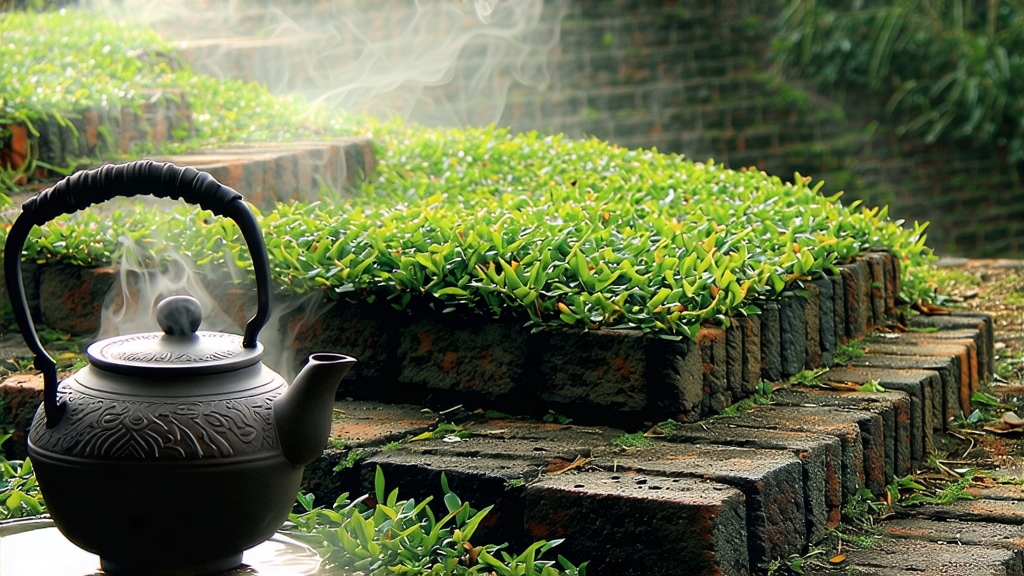
Tucked into the humid, karst-pocked corner of southern China’s Guangxi Zhuang Autonomous Region, the small town of Liubao has given the world one of its most cellar-worthy teas. To the Chinese palate Liu Bao (literally “Six Forts”) is heicha—dark tea—not the familiar English “black tea” made from fully oxidized leaves. International drinkers who think they know dark tea only through Yunnan’s Pu-erh are often startled to discover Liu Bao’s deeper, duskier voice: a basso profundo of camphor, damp bark, and a fleeting sweetness that Chinese tasters liken to longan or betel nut.
1. From Ming-era Tribute to Cold-war Commodity
The first written record appears in the 1567 edition of the Guangxi Provincial Gazetteer: “Liubao tea, compressed in bamboo, sent northward as tribute.” By the Qing dynasty the tea had become the currency of the Horse Tea Trade, traveling with mule caravans from Xing’an county through the Yumen Pass to Mongolia and, eventually, to Russia’s brick-tea factories. When the Trans-Siberian Railway replaced caravans in 1903, Liu Bao lost its northern monopoly and retreated into provincial obscurity. Ironically, the 1970s boom in Hong Kong dim-sum culture revived it: restaurateurs wanted a dark, digestion-friendly tea that could stand up to pork dumplings and custard tarts. Overnight, 20-ton lots of 1950s-vintage Liu Bao were unearthed from humid Hong Kong warehouses, their bamboo husks tattooed with mildew yet the leaves inside miraculously fragrant. Prices soared, and Liu Bao’s second life began.
2. Terroir: Where Mist Meets Mineral
The Liu Bao growing zone sits at 23–24 °N, 200–500 m above sea level, where the Qin and Nanling ranges squeeze warm, monsoon-laden air into a perpetual mist. Lateritic red soils, rich in iron and potassium, force the tea bushes (predominantly the large-leaf var. sinensis cv. Liubao Quntizhong) to send roots deeper, pulling up minerals that translate into a signature “wet stone” note. Because the region sits just below the frost line, the plants flush year-round; the most prized pickings occur in late April when two leaves and a bud are still tender yet already carry the high polymer polyphenols that will later mellow into earthy complexity.
3. Craft: Sun-withering, Wet-piling, and the Bamboo Basket Secret
Although Liu Bao is sometimes marketed as “post-fermented,” the transformation is actually a controlled microbial fermentation that begins the moment the leaves leave the tree.
- Kill-green is brief: 3–4 min at 160 °C in a waist-high, dragon-bone wok. The goal is to rupture leaf cells without destroying the oxidative enzymes that will drive later microbial action.
- Rolling is done barefoot on rattan mats; the foot’s arch applies even pressure that twists the leaf into tight cords without shredding surface hairs.
- Sun-withering lasts 40–60 min, just long enough for 65 % moisture loss. Locals call this “letting the mountain breathe on the leaf.”
- Wet-piling (dui zi) is Liu Bao’s pivotal step. Leaves are sprayed with misty mountain water, then piled 60 cm high under tarpaulins. Internal temperature climbs to 55 °C within 24 h; every 48 h the pile is turned, aerated, and re-moistened. Over 10–15 days the leaf color shifts from olive to umber as Aspergillus niger, Blastobotrys adeninivorans, and a guild of local yeasts metabolize caffeine and tannins into theobromine and novel amin acids responsible for Liu Bao’s sweet aftertaste.
- Bamboo-basket aging follows. The fermented tea is steamed for 30 s, rammed into 40 kg cylinders lined with fresh bamboo bark, then pressed with a 200 kg stone disc. The bamboo imparts a subtle green-coconut aroma and regulates humidity, allowing a slow, aerobic maturation that can last anywhere from 3 to 50 years.
4. Grades and Styles
Liu Bao is classified by leaf grade and vintage, not by mountainside estate.
- **First Grade (Te